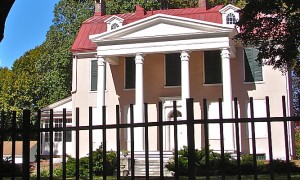The American brick industry has a long history. This should come as no surprise to Philadelphians: We have been using clay-fired brick for centuries to construct many of the city’s renowned architectural gems, including Independence Hall. When Independence Hall was under construction, from 1732 to 1753, America’s entire northeast region was ablaze with the kilns that were baking the building blocks of a nation. For evidence of America’s love affair with brick (and now reclaimed brick), look no further than historical downtown Philadelphia.
Reclaimed brick has a strongly nostalgic quality, which is likely why it is popping up in homes all over Philly. If you would like reclaimed brick in your home, you can either buy reclaimed bricks or reclaim your own.
Clean
Cleaning is a crucial step in the reclamation of brick. To remove efflorescence buildup from mineral salts, use a simple vinegar and water solution. If you have excessive buildup, you will need a stronger solution, such as a 10% solution of muriatic acid, which can be purchased in hardware stores, or CLR. If your bricks are stained with iron deposits, use a 10% solution of oxalic acid.
Strip Down
If your exposed brick is painted but you prefer the natural look, remove the old paint by applying a commercial-grade paint stripper or by using heat (from a blow torch or heating gun). Once the paint has been loosened by the heat, you can scrape it off with a wire brush.
It is important to note that commercial-grade paint stripper is extremely caustic and should be applied only when you are protected with a mask and gloves and have excellent ventilation in the room. The paint stripper is also extremely flammable. Additionally, the paint you are removing may contain lead, so be sure to take appropriate lead paint safety precautions.
Repoint
If your brick is in rough shape, with cracked or crumbling mortar, you will need to redo the mortar with a process called repointing. Repointing not only improves the appearance of the brick but will also make it more structurally sound.
Repointing involves removing the existing mortar with a hammer and chisel and then removing the last traces with a wire brush and water. Use a pointing trowel to fill gaps with new mortar. When starting, begin with the vertical joints. When they are finished, move to the horizontal joints to avoid impairing the structural integrity of the wall. Once the mortar has dried, apply a high-grade masonry sealant to prevent water damage.
Paint
Not everyone decides to paint reclaimed brick, but for some the natural look is not an option because the existing brick may be too damaged to repair. If you decide to paint, you should wait about a month between stripping and repointing to give the brick time to expel excess moisture and caustic chemical residue.
When you select your paint, choose from cement- or latex-based varieties that will prevent moisture from entering the brick while permitting enough breathing to keep the bricks in excellent condition.
If you choose against both the natural look and paint, you still have some options. You can apply a stain to slightly darken the color and to blend aged spots. Another option is a simple, colorless seal that you can buy in low, medium, or high gloss. A seal will give the brick a little boost in appearance while preserving the natural appearance.
[cf]skyword_tracking_tag[/cf]







[…] If …read more […]
I have purchased 5 palettes of reclaimed brick. They are outside. My project is delayed and the palettes, that were shrink wrapped for transport, are going to be outside for two months. Should I remove the shrink wrap (it is sweating) and also put a tarp over the brick?
Thanks for the interesting read about reclaimed bricks. I actually didn’t know that it’s possible to get rid of any efflorescence buildup by using a vinegar and water solution. I’m kind of interested to learn more about how to measure this solution, especially if having an accurate measurement can affect how effective it works.